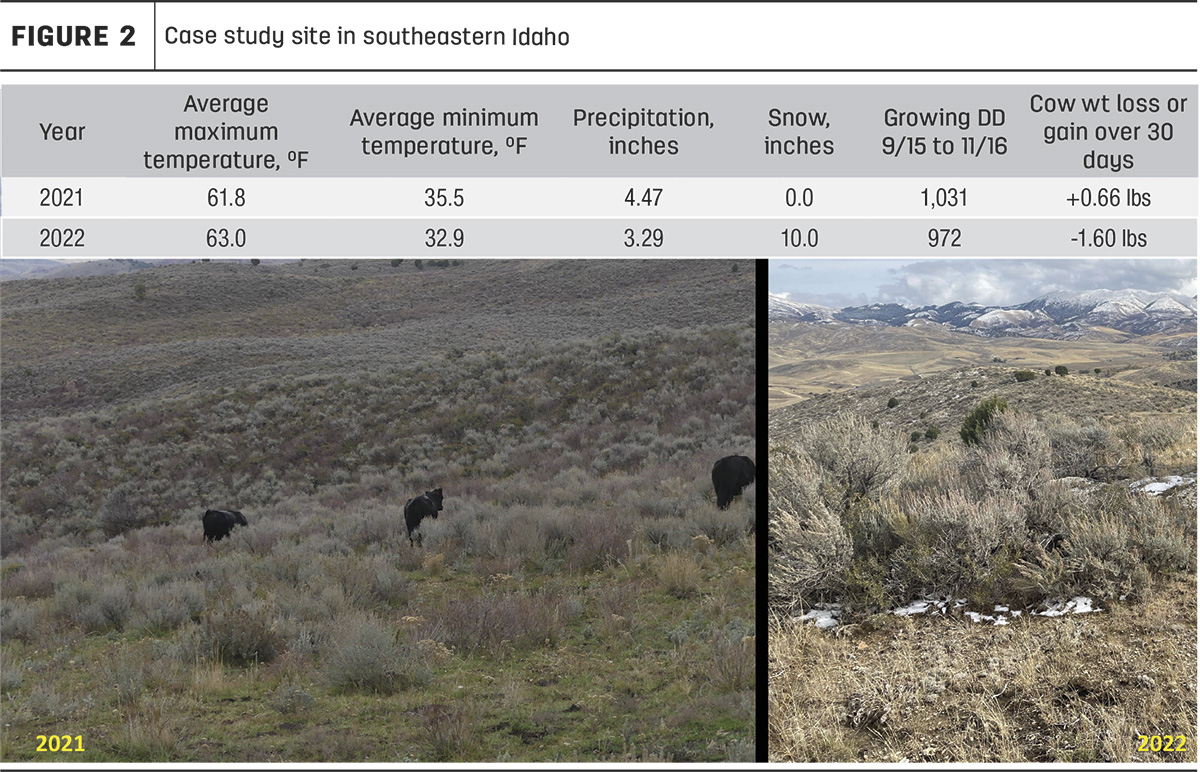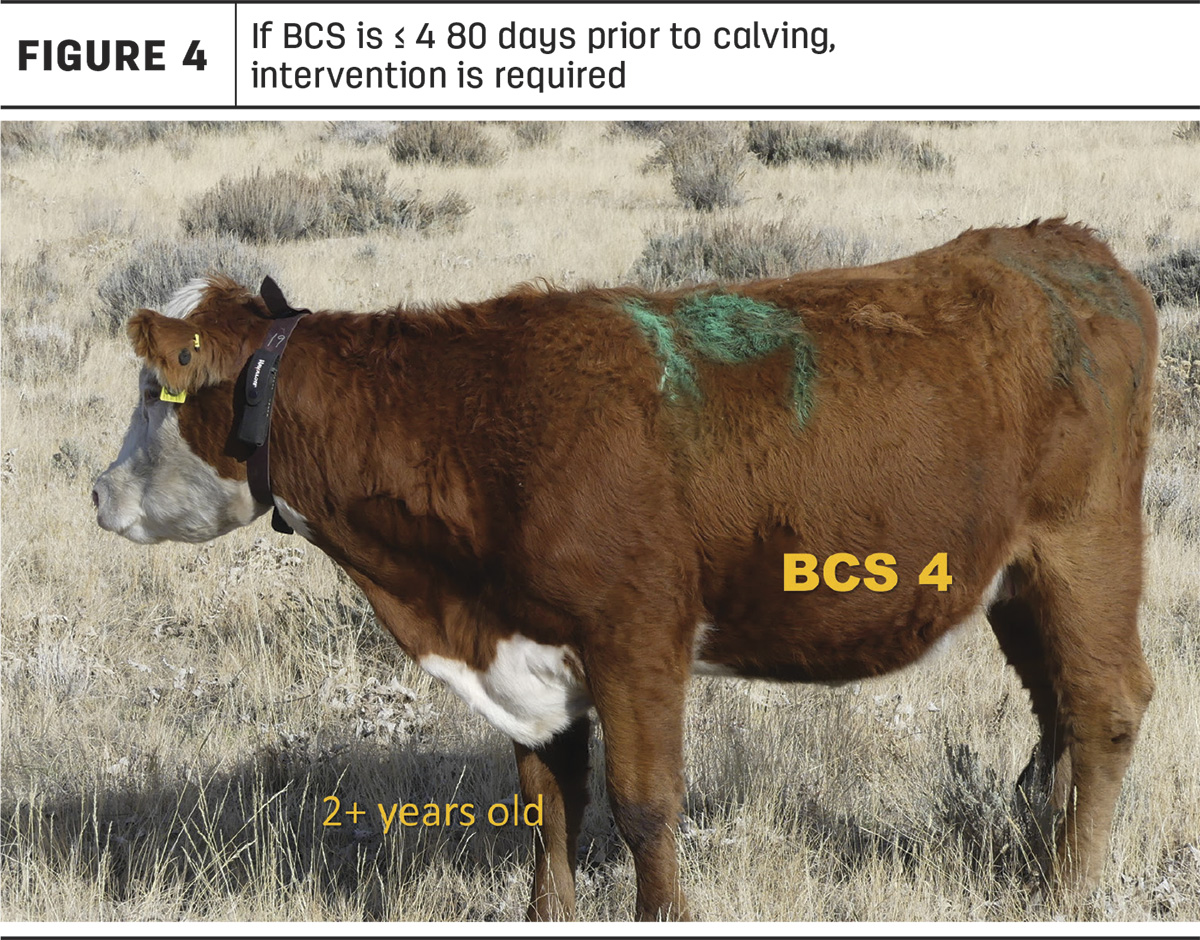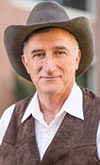Across most of the western U.S., forage quality often declines below that needed to maintain or add body condition to mature cows after traditional fall calf weaning.
Mature cows need to consume 1.8% to 2% of their bodyweight to maintain weight, but as forage quality declines below 7% crude protein (Figure 1), forage intake decreases below that needed to maintain bodyweight.
As forage ages, the amount of fiber (cellulose and lignin) increases and the percent crude protein declines. The grazed forage is more slowly digested by rumen microbes due to the increase of cell wall constituents in the plants.
Providing more rumen-degradable protein in the form of a protein supplement allows rumen microbes to increase in population, thus allowing for more microbes to break down and digest the forage into volatile fatty acids, which are absorbed through the rumen and used as an energy source.
Protein supplementation will also speed up the passage rate of the forage from the rumen, allowing the cow to eat more forage to help satisfy maintenance requirements. Some rumen microbes will also pass into the lower digestive tract and can be used as a protein source by the cow.

Goal of protein supplementation
A goal of any beef cow operation should be to have cattle achieve a body condition score (BCS) of 5 at the time of calving. In order for this to happen, at least 70% of the cow herd should be at a BCS of 5 or greater 80 days before the start of calving. “Hard keeper” cattle that are thin following weaning and the fall grazing period may be separated from the rest of the herd and provided with a better-quality diet. Cattle that are at a BCS of 5 at calving have the necessary body stores to accommodate the weight loss that usually occurs the first 60 days of lactation and will cycle more easily for breeding. In most years, cattle maintained on native rangeland pastures after fall weaning need some type of protein supplement. If cattle are provided a protein supplement, they will usually gain about 0.5 BCS between weaning and the time they are brought home to hay meadow stubble or fed hay. Table 1 illustrates the results of research done at the Eastern Oregon Agricultural Research Center in Burns, Oregon, and demonstrates the economic benefit of calving at a BCS of 5. Cattle that achieved a BCS of 5.3 versus 4.4 at calving had greater pregnancy rates and calf survivability. It appears that fetal programming occurred as well since more steer calves tended to grade Choice from the better-conditioned cows.

Look at forage and look at cow BCS: Idaho case study
A two-year study was initiated in southeastern Idaho to evaluate non-lactating cow performance with only the benefit of dormant forage and no protein supplementation. In some years, forage quality may be sufficient for a period of time in late fall to maintain cow body condition without the addition of protein supplements. 2021 was such a year throughout much of Idaho. We received rain in October that caused greenup of native cool-season grasses (especially Sandberg bluegrass), particularly on south-facing and western-facing slopes. At our study site (Figure 2), we received 3.7 inches of rain during October just prior to and following turnout of the cattle on a 1,500-acre upland sagebrush steppe pasture. In 2021, green grass was 7 inches tall, and in 2022 forage was dormant with only tinges of green. The growing degree days from the nearest weather station were less in 2022. Cows in 2021 gained 0.66 pound per day and began and ended the fall grazing period with a BCS of 5. Cows in 2022 lost 1.6 pounds per day and began the fall grazing period with a BCS of 5 and finished with a BCS of 4.

Based upon the results of this experimental data, I was able to use nutrient requirement calculations from published research to predict future performance. Evaluating these 2022 cows in late November generated the following. For the next 60 days, if these cows had access to 52% total digestible nutrients (TDN) forage and 1 pound of protein supplement per day (fed once a week) and ate 2.1% of their bodyweight, we would predict 0.2 to 0.4 pound average daily gain (ADG). If TDN was 58%, we would predict 0.6 to 1 pound ADG. If intake increased to 2.3% of their bodyweight with 1 pound of protein supplement, we would predict 0.6 pound ADG for 52% TDN and 1.2 ADG for 58% TDN. With no supplement and 52% TDN (assuming maximal intake at 2% of bodyweight), we would predict 0.02 pound ADG and for 58% TDN, 0.4 ADG.
The general recommendation is to have cows be at a BCS of 5 at calving (Figure 3). Considering that each change in BCS is 100 pounds for these cows, we needed to gain 1.2 pounds per day if cows calved in February and 0.95 pound per day if cows calved in March. If we go with the actual weight loss shown in the data, we could halve that weight gain. However, we should consider that when we note the weight of the developing fetus, weight loss increases. A 200-day fetus plus fluids weighs 53 pounds, and a 215-day fetus weighs 60 pounds. Therefore, it appeared that some type of nutritional intervention beyond medium-quality hay would be recommended for these cows between late November and calving. If you had access to excellent quality hay (62% to 64% TDN), cows could be expected to gain 0.9 to 1.4 pounds per day, and no supplement would be required. If cows had finished the fall grazing period at a 3.5 BCS, then 20% grain would need to be added to the daily ration to achieve a final BCS of 4.7 at calving. To achieve a final BCS of 5 for these thin cows, it would require 39% grain in the diet, which would greatly increase feed expenses.


There was an ad campaign in 1971 for an oil filter company that said, “You can pay me now, or pay me later.” If you have the capability to feed protein supplement to cows when forage quality is lacking, this will be less expensive than trying to add 0.5 to 1 BCS back on cows before calving. Generally, it will cost two to three times more to add on weight than to prevent weight loss from occurring. Keeping an eye on both cow condition (Figures 3 and 4) and forage quality during late-season grazing on range is a critical control point for profitability. Looking at cow BCS 80 days prior to calving is a good tool: if BCS is greater than 5 BCS, you are on target, and if BCS is less than or equal to 4, intervention is required.
For more information on supplementation, including a decision support tool, please visit the University of Idaho Drought Resources for Livestock Producers website and view the webinar video titled "Strategic Supplementation for Drought and Dormant Season Grazing."











